A rich black fruit butter that tastes a little like raisins. Nannyberry butter is the best thing you can make from wild nannyberries.
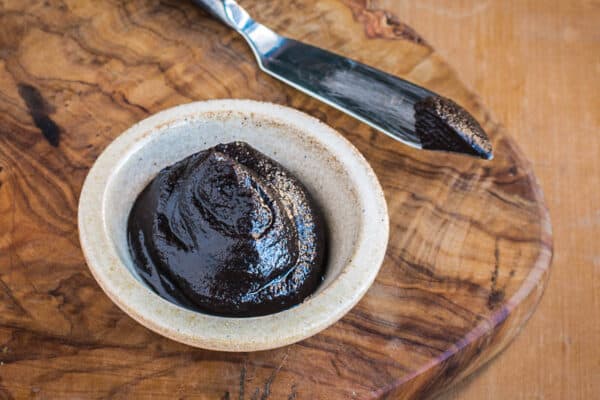
I finally remembered to get to the nannyberry patch this year, also known as a patch of landscaping around one of my favorite disc-golf parks. I'd tasted nannyberries before, and liked the sort of raisin-prune-meets-dark-banana flavor they have going on, but I'd never managed to get over and harvest them.
I'm unsure of the exact species, as there are many, but Viburnum lentago is most widely known, and for culinary purposes of making nannybutter they're all basically interchangeable.
Many common names
Part of the reason I never got to them is that nannyberries, (also known as sheep berries, black haw, witherod, and wild raisin depending on the species according to Sam Thayer) ripen later in the season compared to most berries (I picked these in late September) which means they're easy to forget about when things like hen of the woods start popping up.
It's a lot quicker to pluck a 5 lb hen from a tree than spend an hour gathering a gallon of berries, that, just like the hen, will still need further processing. Now, I see the berries as a season extender, something I can pick after the raspberries and blueberries are long gone.
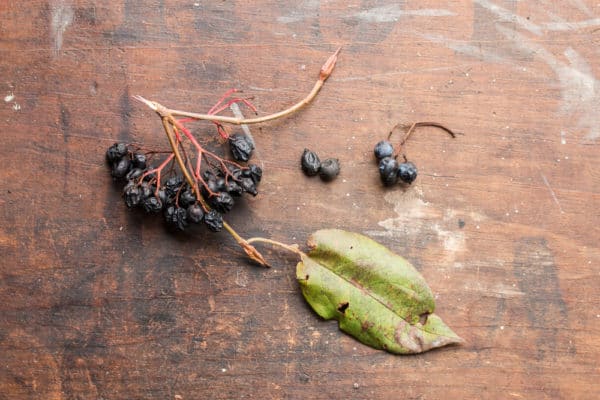
I wanted the nannyberries because I'd never had them before, but more specifically I haven't had product they become: nannybutter. Nannyberries have a fleshy, pastey (in a good way) taste--they're not something you're going to make into jelly.
Just like highbush cranberries, you'll need to separate the flat seeds before eating, and the best way to do that is to combine them with water, cook, and pass through a food mill while hot. The product you're left with is a sort of dark, prun-y nannyberry butter, and it is good.
Unlike traditional jams and jellies, if you concentrate the butter, you could probably get by without sweetening it at all, since no sugar is needed to help set pectin--it's thick all by itself.
I do like a little sweet in my preserves for flavor as much as the improved shelf-life, so I added maple to mine. It's just sweet enough to be interesting, which I think makes the nannyberries taste more like themselves.
There aren't a lot of resources in print or online for making nannyberry butter sans Forager's Harvest, but it's not rocket science. The only real variable I thought was how thick to make it (it should just hold up a spoon) which you can easily dial-in by baking a puree slowly and whisking here and there--handy if a food mill (the ideal tool here) isn't available since all you need to do is strain the puree through a colander, china cap, or something similar.
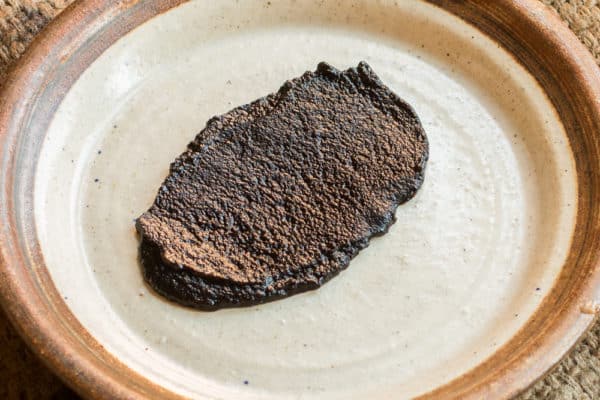
Baking thick purees on low heat Is the same process I use for making large batches of dulce de leche, apple butter, and caramelized banana puree. The 360 degree heat of an oven not only evaporates evenly, preventing scorching, but gently caramelizes the puree with heat that adds nice toasty notes. That being said, there's more than one way to get from point a to point b, depending on your set-up, but a food mill is the best.
Notes
Flavor Pairings
Once you make the nannyberry butter, it's great anywhere you'd use a fruit spread, but can also be combined with dairy or even water in equal proportions by volume to stretch it for desserts.
All you have to do is plug it into your panna cotta, mousse, ice cream, jam bar-cookie recipe-anywhere the flavor of prune-bananas would be nice. The flavor affinities are easy to pick out too. If it would taste good with prunes or bananas, it'll be great. Here's a few sweet and savory partners your nannyberries would love:
- Brandy and cognac
- Citrus, especially orange
- Warm spices: cinnamon, cardamom, nutmeg, allspice and cloves, in small amounts
- Maple syrup and brown sugar
- Ginger
- Nuts, especially walnuts, butternuts, and black walnuts
- Oats
- Liver, especially poultry
- Meat like pork, game birds and other poultry
Storage
I froze all of mine in vacuum pouches. If you want to keep fruit butters like this for the long term, I would recommend pressure canning, or freezing. This is a very low sugar preserve, so I'm hesitant to recommend water bath canning this. If anyone has done so, chime in.
Cooking and Scaling
I have specific proportions here, but this can be scaled up or down easily. All you're doing is adding water to your nannyberries until they're nearly covered, cooking low and slow, and straining.
More Nannyberries
There's lots of fun stuff you can make with the finished puree--just think bananas. Here's a few ideas.
Maple Nannyberry Butter / Puree
Equipment
- Food mill or high speed blender
Ingredients
Nannyberry puree
- 10 cups nannyberries
- 7 cups water
Nannyberry Butter
- 1 cup maple syrup (optional)
- 5 cups Nannyberry puree
- ¼ tsp Cinnamon
- 1 pinch Kosher salt
Instructions
Nannyberry Puree
- Wash the nannyberries well and drain, then combine with the water, bring to a simmer, and cook, covered, for 40-45 minutes on low heat, mashing them up to make a thick puree.
- Depending on how fresh or dry your fruit are, you may need to add more water to get the fruit really mashed up. It’s ok if the mixture seems a little soupy or loose, since you can always cook the puree down slowly afterward to concentrate it. Dried nannyberries may need more water than very fresh ones to become a puree, so use your instinct.
- Pass the mixture through a foodmill with a large die (large holes). My largest food mill screen is just barely small enough to not allow the seeds through, but some aren’t.
- If the mixture is liquid enough, I’ve had success pulsing it with a handblender or in a food processor to get extra puree from the nannyberries, but you need to be careful of the seeds as they’re brittle. If you pass your nanny butter through a food mill and still see a seed or two, pass it through a finer screen before storing.
Nanny Butter
- For nannyberry butter add 1 cup maple to the 5 cups of puree along with ¼ teaspoon cinnamon and a pinch of salt, then puree in a blender in batches to make it extra smooth, pour it into a shallow pan and bake, whisking occasionally for about 30 minutes at 325 or until thickened.
- Double check the seasoning, adjust until it tastes good to you, then store in a jar in the fridge for up to a week, or freeze.

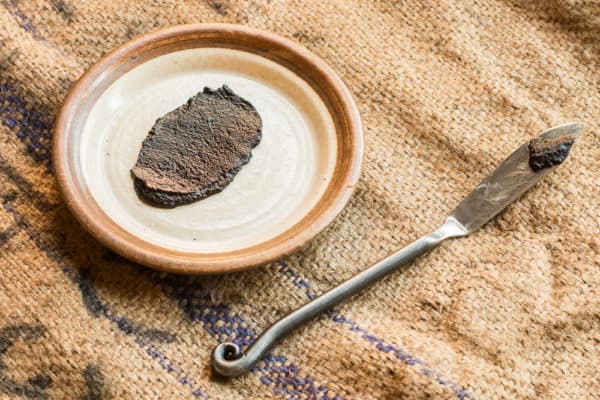
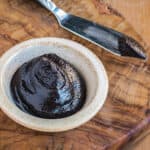
Tanya Sousa
Thank you for this! I only recently learned about nanny berries and serendipitously found bushes of them under a tree in a field while walking my dog a week or so ago. Checked the leaves/berries and... YES! Nanny berries! Made the nanny berry butter the other day and love it! Thinking of trying it with some baked brie sooner than later. 🙂
Alan Bergo
Great. You can also use the purée in quick breads
Ashley
Wild raisin, at least around here, has a very different taste and growth habit. The fruits are much smaller, face upright (rather than droop like nannyberries) and they really taste like raisins (as opposed to nannyberry's banana/prune thing). They also ripen much earlier. We still have plenty of highbush cranberries and nannyberries hanging on the branches, even up here in zone 4 VT in December. I have a bit patch of nannyberries I'm going to hit up later this week, to make exactly this. (The wild raisins get picked off much earlier, and the hobbleberries which are the best tasting of all, are long gone too.)
Beautiful nannyberry spread, you really have a talent for making food look amazing.
Alan Bergo
Thanks Ashley. I've been curious about the different species. I'll have to ask Sam if we have any others around. It was really nice to be able to go pick them after everything else is gone!
Jennifer
Well, thank you for this post! This is my first year really trying to understand the edible and medicinal value of the plants growing on our property, and it has been a fascinating study. It was with some trepidation that I tasted this berry, and it was surprisingly tasty, so I look forward to harvesting more and trying your recipe. Thank you again!
Linda
I didn't know those were edible. We have Viburnum lentago here. Not sure about the 'meets dark banana' description though. I'll have to try them.
I enjoy reading most of your blogs..... 🙂
Alan Bergo
Thanks Linda, these are a good, underappreciated fruit. "Most of your blogs" - HA!
Maggie
Every time I read one of your posts, my plans for the evening meal get blown ip. I also learn something new, without fail.
Thanks! I believe in tithing in return for such a bountiful harvest of information, such as you provide. Is there a way that I can do that from time to time?
Thanks for everything. Im not making meatloaf after all tonight.
Mags
Alan Bergo
Sorry for blowing up dinner. And I absolutely accept tithes of information, and appreciation. Making sure to pick up a copy of my book when it gets released a little over a year from now wouldn't hurt either. Thanks Maggie.